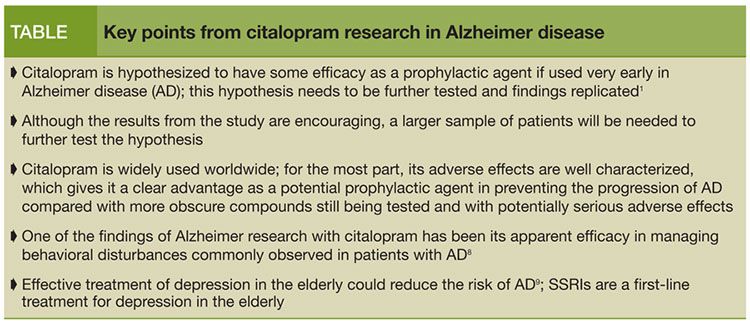Publication
Article
Psychiatric Times
The Monoaminergic System and Its Putative Role in Alzheimer Disease
Author(s):
The SSRIs, although principally targeting serotonin transporter, are complex drugs that might work on other neurotransmitter and receptor systems. It is likely worthwhile to look at the effects of other monoamine and neuropeptide systems on the enzymatic machinery cleaving the amyloid precursor protein.
Table

β-Amyloid plaques are believed to accumulate in the early stages of Alzheimer disease, leading to the development of symptoms, such as memory loss. The plaques occur when enzymatic proteolysis of the amyloid precursor protein (APP) by β-secretase forms the toxic misfolded oligomer β-amyloid.
To build on previous findings on the effects of citalopram on β-amyloid plaques, Sheline and colleagues1 evaluated the role of the serotonergic system in an animal model of Alzheimer pathology as well in healthy human volunteers. Citalopram was found to halt the growth of existing β-amyloid plaques and reduce the formation of new ones by 78%; the drug also decreased β-amyloid in the cerebrospinal fluid in healthy adults.
Although these findings are important and point to a different direction for research, what makes it perhaps all the more interesting is the drug used. Citalopram is an SSRI and its mode of action, although not entirely clear, begins with blockade of the serotonin transporter-a protein that transfers serotonin from the synaptic cleft to the presynaptic neuron. Its therapeutic mode of action is therefore, at least initially, to modulate the serotonergic system by way of its receptors.
Relatively recent research has pointed to downstream effects in cellular architecture as well as at gene level.2 More striking is the finding that SSRIs relieve depression by inducing the proliferation of brain-derived neurotropic factor. Ultimately, the relief of depression has been associated with the degree of neurogenesis-a revolutionary finding given that the brain has been understood to be static in adults. If citalopram is theoretically capable of relieving depression by promoting neurogenesis, could that be an explanation for the findings in the study by Sheline and colleagues? It is clearly not that easy; neurogenesis and the associated relief of depression occurs over 6 to 8 weeks, and the researchers saw a decrease in β-amyloid formation even after 1 dose of citalopram. Therefore, antidepressant efficacy does not necessarily equate to potential Alzheimer prophylaxis.
The monoamine system in the prevention of plaque formation
Other SSRIs might have the same effect on plaque formation as citalopram.3 Looking at the way SSRIs affect the serotonergic system may help us understand how SSRIs affect plaque formation-which receptors and second messenger molecules are involved. Pimenova and colleagues4 found that agonists that activate the serotonin 4 receptor induce the up-regulation of α-secretase activity. This action leads to the cleavage of APP into a soluble (good) fragment by way of downstream activation of other intracellular messenger systems.3,4 α-Secretase is a proteolytic enzyme that unlike β-secretase cleaves APP into a soluble and neuroprotective APP fragment form (sαAPP), therefore precluding the formation of the amyloidogenic counterpart β-amyloid peptide.5
The implication of the study by Pimenova and colleagues4 is that serotonin 4 activation would be an initial step in the appropriate cleavage of APP by α-secretase. Despite the link between serotonin, the serotonin 4 receptor, and α-secretase, citalopram is not known to be an agonist or antagonist at the serotonin 4 receptor. One way of reconciling these facts is to think that the initial effect of the SSRIs (not the effects that tend to work for depression, at least initially) is to acutely increase the density of intrasynaptic serotonin. The resulting increase in serotonin density increases the probability of it stimulating other serotonin receptors; therefore, a putative agonism on serotonin 4 would be indirect.
It appears that the extracellular regulated kinase cascade is a key player in the link between serotonin and α-secretase, since its inhibition by experimental manipulation is capable of reversing serotonin-induced β-amyloid reduction.3 The serotonin 4 receptor is another player; it is likely that other serotonergic receptors will end up being as important.
The muscarinic cholinergic system
The cholinergic system plays a key role in learning, memory, and overall cognition. Attempts at enhancing cholinergic neurotransmission are at the heart of common first-line treatments for Alzheimer disease. What is now becoming clear is that the muscarinic cholinergic receptor M1 appears to play a prominent role in augmenting the activity of α-secretase to form the sαAPP oligomer. Pharmacological and behavioral paradigms using agonists and antagonists for the M1 receptor have improved and worsened, respectively, cognitive parameters in animal models, and in vitro analyses have revealed the role of M1 on α-secretase activity.6
Citalopram has been shown to partially target the cholinergic system.7 For instance, citalopram is known to reverse memory impairment by way of increasing acetylcholine activity in the hippocampus in animal models. It has been hypothesized that citalopram improves memory in depressed patients, at least in part, by its modulation of the cholinergic system. The Table presents a summary of key findings from citalopram research in Alzheimer disease.
Conclusion
The SSRIs, although principally targeting serotonin transporter, are complex drugs that might work on other neurotransmitter and receptor systems. It is likely worthwhile to look at the effects of other monoamine and neuropeptide systems on the enzymatic machinery cleaving APP. Further studies are needed to clarify the effects that other well-know compounds currently used in neuropsychiatry could have in alleviating Alzheimer disease.
Disclosures:
Dr Vergne is Assistant Professor in the department of psychiatry at the Tufts School of Medicine in Boston. He reports no conflicts of interest concerning the subject matter of this article.
References:
1. Sheline YI, West T, Yarasheski K, et al. An antidepressant decreases cerebrospinal fluid Aβ production in healthy individuals and in transgenic AD mice. Sci Transl Med. 2014;6:236re4.
2. Sangkuhl K, Klein TE, Altman RB. Selective serotonin reuptake inhibitors pathway. Pharmacogenet Genomics. 2009;19:907-909.
3. Cirrito JR, Disabato BM, Restivo JL, et al. Serotonin signaling is associated with lower amyloid-β levels and plaques in transgenic mice and humans. Proc Natl Acad Sci U S A. 2011;108:14968-14973.
4. Pimenova AA, Thathiah A, De Strooper B, Tesseur I. Regulation of amyloid precursor protein processing by serotonin signaling. PloS One. January 21, 2014. http://www.plosone.org/article/info%3Adoi%2F10.1371%2Fjournal.pone.0087014. Accessed July 10, 2014.
5. Postina R. A closer look at alpha-secretase. Curr Alzheimer Res. 2008;5:179-186.
6. Caccamo A, Oddo S, Billings LM, et al. M1 receptors play a central role in modulating AD-like pathology in transgenic mice. Neuron. 2006;49:671-682.
7. Egashira N, Matsumoto Y, Mishima K, et al. Low dose citalopram reverses memory impairment and electroconvulsive shock-induced immobilization. Pharmacol Biochem Behav. 2006;83:161-167.
8. Pollock BG, Mulsant BH, Rosen J, et al. Comparison of citalopram, perphenazine, and placebo for the acute treatment of psychosis and behavioral disturbances in hospitalized, demented patients. Am J Psychiatry. 2002;159:460-465.
9. Barnes DE, Yaffe K. The projected effect of risk factor reduction on Alzheimer’s disease prevalence. Lancet Neurol. 2011;10:819-828.
Newsletter
Receive trusted psychiatric news, expert analysis, and clinical insights — subscribe today to support your practice and your patients.

















